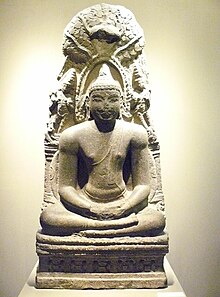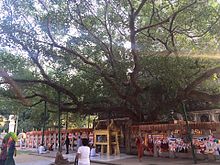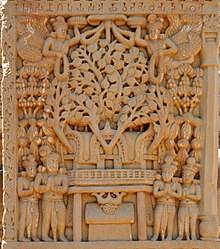Bodhi Tree



Coordinates: 24°41′45.29″N 84°59′29.29″E / 24.6959139°N 84.9914694°E
The Bodhi Tree ("tree of awakening"[1]), also called the Bodhi Fig Tree or Bo Tree,[2] was a large and ancient sacred fig tree (Ficus religiosa[1][3]) located in Bodh Gaya, Bihar, India. Siddhartha Gautama, the spiritual teacher who became known as the Buddha, is said to have attained enlightenment or Bodhi circa 500 BCE under it.[4] In religious iconography, the Bodhi Tree is recognizable by its heart-shaped leaves, which are usually prominently displayed.[5]
The proper term "Bodhi Tree" is also applied to existing sacred fig (Ficus religiosa) trees, also known as bodhi trees.[6] The foremost example of an existing tree is the Mahabodhi Tree growing at the Mahabodhi Temple in Bodh Gaya, which is often cited as a direct descendant of the original tree. This tree, planted around 250 BCE, is a frequent destination for pilgrims, being the most important of the four main Buddhist pilgrimage sites.[7]
Other holy bodhi trees with great significance in the history of Buddhism are the Anandabodhi Tree at Jetavana in Sravasti in North India and the Sri Maha Bodhi Tree in Anuradhapura, Sri Lanka. Both are also believed to have been propagated from the original Bodhi Tree.
Celebrations[]
Bodhi Day[]
On December 8, Bodhi Day celebrates Buddha's enlightenment underneath the Bodhi Tree. Those who follow the Dharma[dubious ] greet each other by saying, "Budu saranai!" which translates to "may the peace of the Buddha be yours."[8] It is also generally seen as a religious holiday, much like Christmas in the Christian west, in which special meals are served, especially cookies shaped like hearts (referencing the heart-shaped leaves of the Bodhi) and a meal of Kheer, the Buddha's first meal ending his six-year asceticism.[9]
Bodhi Puja[]
Bodhi Puja, meaning "the veneration of Bodhi-tree" is the ritual to worship the Bodhi tree and the deity residing on it (Pali: rukkhadevata; Sanskrit; vrikshadevata). It is done by giving various offerings such as food, water, milk, lamps, incense, etc. and chanting the verses of glory of Bodhi tree in Pali. The most common verse is:
"Ime ete mahabodhi lokanathena pujita ahampi te namassami bodhi raja namatthu te."
Origin and descendants[]
Bodh Gaya[]



The Bodhi tree at the Mahabodhi Temple is called the Sri Maha Bodhi. Gautama Buddha attained enlightenment (bodhi) while meditating underneath a Ficus religiosa. According to Buddhist texts, the Buddha meditated without moving from his seat for seven weeks (49 days) under this tree. A shrine called Animisalocana cetiya, was later erected on the spot where he sat.[11]
The spot was used as a shrine even in the lifetime of the Buddha. Emperor Ashoka the Great was most diligent in paying homage to the Bodhi tree, and held a festival every year in its honour in the month of Kattika.[12] His queen, Tissarakkhā, was jealous of the Tree, and three years after she became queen (i.e., in the nineteenth year of Asoka's reign), she caused the tree to be killed by means of mandu thorns.[13] The tree, however, grew again, and a great monastery was attached to the Bodhimanda called the Bodhimanda Vihara. Among those present at the foundation of the Mahā Thūpa are mentioned thirty thousand monks from the Bodhimanda Vihara, led by Cittagutta.[14]
The tree was again cut down by King Pushyamitra Shunga in the 2nd century BC, and by King Shashanka in 600 AD. In the 7th century AD, Chinese traveler Xuanzang wrote of the tree in detail.

Every time the tree was destroyed, a new tree was planted in the same place.[15]
In 1862 British archaeologist Alexander Cunningham wrote of the site as the first entry in the first volume of the Archaeological Survey of India:
The celebrated Bodhi tree still exists, but is very much decayed; one large stem, with three branches to the westward, is still green, but the other branches are barkless and rotten. The green branch perhaps belongs to some younger tree, as there are numerous stems of apparently different trees clustered together. The tree must have been renewed frequently, as the present Pipal is standing on a terrace at least 30 feet above the level of the surrounding country. It was in full vigour in 1811, when seen by Dr. Buchanan (Hamilton), who describes it as in all probability not exceeding 100 years of age.[16]
However, the tree decayed further and in 1876 the remaining tree was destroyed in a storm. In 1881, Cunningham planted a new Bodhi tree on the same site.[17][18]
To Jetavana, Sravasti[]

This section does not cite any sources. (January 2019) |
It is said that in the ancient Buddhist texts[citation needed] in order that people might make their offerings in the name of the Buddha when he was away on pilgrimage, the Buddha sanctioned the planting of a seed from the Bodhi tree in Bodhgaya in front of the gateway of Jetavana Monastery near Sravasti. For this purpose Moggallana took a fruit from the tree as it dropped from its stalk before it reached the ground. It was planted in a golden jar by Anathapindika with great pomp and ceremony. A sapling immediately sprouted forth, fifty cubits high, and in order to consecrate it, the Buddha spent one night under it, rapt in meditation. This tree, because it was planted under the direction of Ananda, came to be known as the Ananda Bodhi.
To Anuradhapura, Sri Lanka[]
King Asoka's daughter, Sanghamitta, brought a piece of the tree with her to Sri Lanka where it is continuously growing to this day in the island's ancient capital, Anuradhapura.[17] This Bodhi tree was originally named Jaya Sri Maha Bodhi, and was a piece of another Bodhi tree planted in the year 245 B.C.[20] Although the original Bodhi tree deteriorated and died of old age, the descendants of the branch that was brought by Emperor Ashoka's son, Mahindra, and his daughter, Sanghmittra, can still be found on the island.[21]
According to the Mahavamsa, the Sri Maha Bodhi in Sri Lanka was planted in 288 BC, making it the oldest verified specimen of any angiosperm. In this year (the twelfth year of King Asoka's reign) the right branch of the Bodhi tree was brought by Sanghamittā to Anurādhapura and placed by Devānāmpiyatissa his left foot in the Mahāmeghavana. The Buddha, on his death bed, had resolved five things, one being that the branch which should be taken to Ceylon should detach itself.[12] From Gayā, the branch was taken to Pātaliputta, thence to Tāmalittī, where it was placed in a ship and taken to Jambukola, across the sea; finally it arrived at Anuradhapura, staying on the way at . Those who assisted the king at the ceremony of the planting of the Tree were the nobles of Kājaragāma and of Candanagāma and of Tivakka.
The Jaya Sri Maha Bodhi is also known to be the most sacred Bodhi tree. This came upon the Buddhists who performed rites and rituals near the Bodhi tree. The Bodhi tree was known to cause rain and heal the ill. When an individual became ill, one of his or her relatives would visit the Bodhi tree to water it seven times for seven days and to vow on behalf of the sick for a speedy recovery.[22]
To Honolulu, Hawaii[]
This section does not cite any sources. (January 2019) |
In 1913, Anagarika Dharmapala took a sapling of the Sri Maha Bodhi to Hawaii, where he presented it to his benefactor, Mary Foster, who had funded much Buddhist missionary work. She planted it in the grounds of her house in Honolulu, by the Nuʻuanu stream. On her death, she left her house and its grounds to the people of Honolulu, and it became the Foster Botanical Garden.
To Chennai, India[]

In 1950, Jinarajadasa took three saplings of the Sri Maha Bodhi to plant two saplings in Chennai, one was planted near the Buddha temple at the Theosophical Society another at the riverside of Adyar Estuary. The third was planted near a meditation center in Sri Lanka.[23]
To Thousand Oaks, California, USA[]
In 2012, Brahmanda Pratap Barua, Ripon, Dhaka, Bangladesh, took a sapling of Bodhi tree from Buddha Gaya, Maha Bodhi to Thousand Oaks, California, where he presented it to his benefactor, Anagarika Glenn Hughes, who had funded much Buddhist work and teaches Buddhism in the USA. [24] He and his students received the sapling with a great thanks, later they planted the sapling in the ground in a nearby park.
To Nihon-ji, Japan[]
In 1989, the government of India presented Nihon-ji with a sapling from the Bodhi Tree as a gesture of world peace.[citation needed]
The trees of the previous Buddhas[]
According to the Mahavamsa,[25] branches from the Bodhi trees of all the Buddhas born during this kalpa were planted in Ceylon (Sri Lanka) on the spot where the sacred Bodhi tree stands today in Anurādhapura. The branch of Kakusandha's tree was brought by Rucānandā, Konagamana's by Kantakānandā (or Kanakadattā), and Kassapa's by Sudhammā.[citation needed]
See also[]

- Atamasthana
- Bodhi
- Sacred related
- Sacred trees
- Largest Banyan trees
- Sacred groves
- Sacred groves of India
- Tree worship
- Sacred mountains
- Sacred natural site
- Sacred rivers
- Sacred site
- Sacred trees
- General
- List of types of formally designated forests
- Superlative trees
- Tree hugger (disambiguation)
- World mountain
References[]
- ^ Jump up to: a b Gethin, Rupert (1998). The Foundations of Buddhism. Oxford University Press. p. 22. ISBN 9780192892232.
- ^ "Buddhism Fast Facts". CNN. Retrieved 2019-10-14.
- ^ Simon Gardner, Pindar Sidisunthorn and Lai Ee May, 2011. Heritage Trees of Penang. Penang: Areca Books. ISBN 978-967-57190-6-6
- ^ Gopal, Madan (1990). K.S. Gautam (ed.). India through the ages. Publication Division, Ministry of Information and Broadcasting, Government of India. p. 176.
- ^ For more on the topic see also the chapter “Buddha, Buddhism, and the bodhi tree” in “Belief, Bounty, and Beauty” by Albertina Nugteren. doi:10.1163/9789047415619_004
- ^ "Ficus religiosa - Plant Finder". www.missouribotanicalgarden.org. Retrieved 2020-12-08.
- ^ "Botanic Notables: The Bodhi Tree - Garden Design". GardenDesign.com. Retrieved 2020-12-08.
- ^ "University of Hawaii".[dead link]
- ^ Prasoon, Shrikant (2007). Knowing Buddha : [life and teachings]. [Delhi]: Hindoology Books. ISBN 9788122309638.
- ^ A small Hindu temple beneath a banyan tree, Bodhgaya British Library.
- ^ Animisalocana cetiya
- ^ Jump up to: a b "CHAPTER XVII_The Arrival Of The Relics". Mahavamsa, chap. 17, 17.
- ^ "CHAPTER XX_The Nibbana Of The Thera". Mahavamsa, chap. 20, 4f.
- ^ "CHAPTER XXIX_The Beginning Of The Great Thupa". Mahavamsa, chap. 29, 41.
- ^ J. Gordon, Melton; Martin, Baumann (2010). Religions of the World: A Comprehensive Encyclopedia of Beliefs and Practices (Second ed.). ABC-CLIO, Santa Barbara. p. 358. ISBN 978-1598842043.
- ^ Archaeological Survey of India, Volume 1, Four Reports Made During the Years 1862-63-64-66
- ^ Jump up to: a b "Buddhist Studies: Bodhi Tree". Buddhanet.net. Retrieved 2013-08-01.
- ^ Mahâbodhi, or the great Buddhist temple under the Bodhi tree at Buddha-Gaya, Alexander Cunningham, 1892: "I next saw the tree in 1871 and again in 1875, when it had become completely decayed, and shortly afterwards in 1876 the only remaining portion of the tree fell over the west wall during a storm, and the old pipal tree was gone. Many seeds, however, had been collected and the young scion of the parent tree were already in existence to take its place."
- ^ Luders, Heinrich (1963). Corpus Inscriptionum Indicarum Vol.2 Pt.2 Bharhut Inscriptions. p. 95.
- ^ K.H.J. Wijayadasa. "Śrī Maha Bodhi". Srimahabodhi.org. Retrieved 2013-08-01.
- ^ George Boeree. "History of Buddhism". Webspace.ship.edu. Retrieved 2013-08-01.
- ^ "Rain-makers: The Sacred Bodhi Tree Part 2". Srimahabodhi.org. 2003-04-24. Retrieved 2013-08-01.
- ^ Madhavan, Chitra. "Buddhist shrine in Adyar". Madras Musings. Madras Musings. Retrieved 14 November 2015.
- ^ See “Navel in Buddha” on Academia.edu https://www.academia.edu/43042460/Navel_in_Buddha. Text is quoted verbatim. Multiple internet sites show the same text, but only this one appears to be a more reliable source.
- ^ "CHAPTER XV_The Acceptance Of The Mahavihara". For example, chap 15.
External links[]
- Bodh Gaya
- Trees in religion
- Individual trees in India
- Buddhist pilgrimage sites in India
- Trees in Buddhism
- Individual fig trees
- Gautama Buddha
